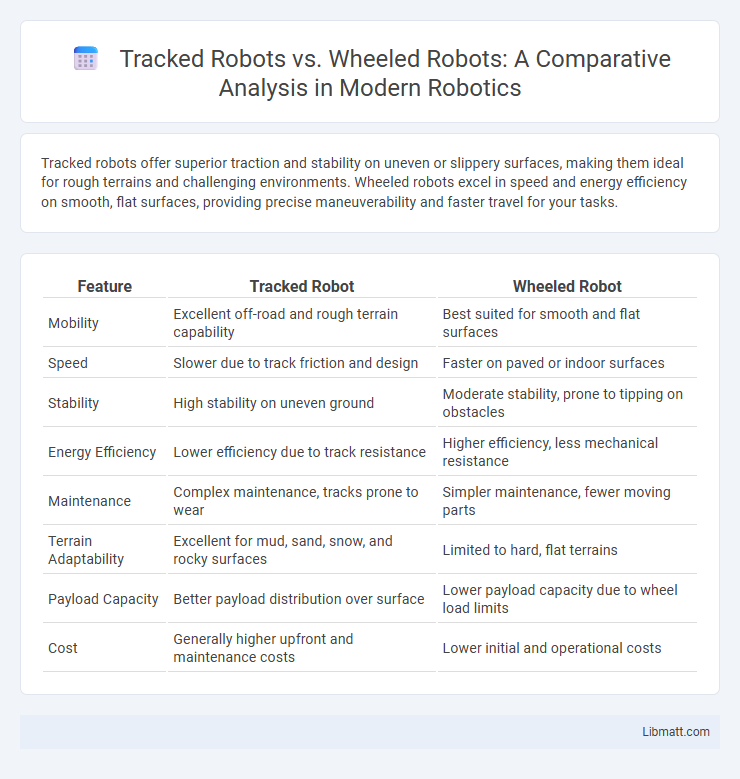Tracked robots offer superior traction and stability on uneven or slippery surfaces, making them ideal for rough terrains and challenging environments. Wheeled robots excel in speed and energy efficiency on smooth, flat surfaces, providing precise maneuverability and faster travel for your tasks.
Table of Comparison
| Feature | Tracked Robot | Wheeled Robot |
|---|---|---|
| Mobility | Excellent off-road and rough terrain capability | Best suited for smooth and flat surfaces |
| Speed | Slower due to track friction and design | Faster on paved or indoor surfaces |
| Stability | High stability on uneven ground | Moderate stability, prone to tipping on obstacles |
| Energy Efficiency | Lower efficiency due to track resistance | Higher efficiency, less mechanical resistance |
| Maintenance | Complex maintenance, tracks prone to wear | Simpler maintenance, fewer moving parts |
| Terrain Adaptability | Excellent for mud, sand, snow, and rocky surfaces | Limited to hard, flat terrains |
| Payload Capacity | Better payload distribution over surface | Lower payload capacity due to wheel load limits |
| Cost | Generally higher upfront and maintenance costs | Lower initial and operational costs |
Introduction to Tracked and Wheeled Robots
Tracked robots feature continuous tracks that provide superior traction and stability on uneven or rough terrain, making them ideal for challenging outdoor environments. Wheeled robots, equipped with wheels, offer greater speed and energy efficiency on smooth surfaces, enhancing maneuverability in indoor or flat settings. Your choice between tracked and wheeled robots depends on the specific terrain and operational requirements of your application.
Key Differences Between Tracked and Wheeled Robots
Tracked robots offer superior traction and stability on rough, uneven terrain due to their continuous track design, while wheeled robots excel in speed and energy efficiency on smooth surfaces. The key differences lie in mobility and adaptability: tracked robots handle obstacles and slopes better, whereas wheeled robots provide greater maneuverability and faster travel on flat ground. Your choice depends on the operating environment and mission requirements, balancing terrain challenges against speed and energy consumption.
Terrain Adaptability and Mobility
Tracked robots excel in terrain adaptability by distributing weight evenly across tracks, enabling superior traction on uneven, soft, or slippery surfaces such as mud, sand, and snow. Wheeled robots offer higher mobility and speed on flat, hard surfaces but struggle with obstacles, loose terrain, and steep inclines compared to tracked counterparts. The choice between tracked and wheeled robots depends on mission requirements, prioritizing either rugged terrain navigation or efficiency on smoother environments.
Speed and Efficiency Comparison
Tracked robots typically offer superior traction and stability on rough or uneven terrain, but their top speeds are generally lower compared to wheeled robots. Wheeled robots excel in speed and energy efficiency on smooth surfaces, making them faster and less power-consuming in such environments. Choosing between tracked and wheeled robots depends on the specific application terrain, where tracked models prioritize rough-ground mobility and wheeled types emphasize speed and operational efficiency.
Maneuverability in Confined Spaces
Tracked robots excel in maneuverability within confined spaces due to their continuous track design, distributing weight evenly and enabling smooth traversal over obstacles and tight turns. Wheeled robots offer faster speeds but struggle with sharp turns and uneven terrain, limiting their effectiveness in narrow or cluttered environments. The superior grip and stability of tracked robots make them better suited for tasks requiring precise navigation in restricted areas.
Durability and Maintenance Needs
Tracked robots offer superior durability on rough and uneven terrains due to their continuous track design, which distributes weight more evenly and resists damage from sharp objects. Wheeled robots require less frequent maintenance because wheels have fewer contact points and simpler mechanical components but are more prone to wear on abrasive surfaces. The maintenance needs for tracked robots are higher, involving track tension adjustments and potential track replacements, while wheeled robots typically need regular tire pressure monitoring and wheel alignment.
Energy Consumption and Power Efficiency
Tracked robots generally consume more energy than wheeled robots due to increased friction and mechanical complexity of the tracks, which require more power to maintain movement. Wheeled robots offer higher power efficiency on smooth surfaces because of lower rolling resistance and simpler drive mechanisms. Choosing the right robot type impacts your energy budget and operational endurance, making wheeled robots preferable for extended tasks on flat terrain.
Cost Considerations and Budget Impact
Tracked robots generally incur higher costs due to complex suspension systems and increased maintenance requirements, impacting long-term budget planning. Wheeled robots offer a more cost-effective solution with lower initial purchase prices and reduced upkeep expenses, making them suitable for budget-sensitive projects. Organizations must balance performance needs with financial constraints when choosing between tracked and wheeled robotic platforms.
Application Suitability: Industrial to Exploration
Tracked robots excel in rough terrain navigation and heavy-duty industrial applications due to their enhanced stability and traction, making them ideal for construction, mining, and planetary exploration. Wheeled robots offer greater speed and efficiency on smooth surfaces, suitable for warehouse automation, factory floor tasks, and indoor surveillance. Your choice depends on the operational environment, with tracked models preferred for uneven, rugged conditions and wheeled variants better for flat, controlled settings.
Choosing the Right Robot: Factors to Consider
Choosing between a tracked robot and a wheeled robot depends on terrain type, maneuverability, and stability requirements. Tracked robots excel on rough, uneven surfaces and provide superior traction, making them ideal for off-road or obstacle-laden environments. Wheeled robots offer higher speed, efficiency, and easier maintenance on smooth surfaces, suitable for indoor or flat outdoor applications.
Tracked Robot vs Wheeled Robot Infographic

 libmatt.com
libmatt.com